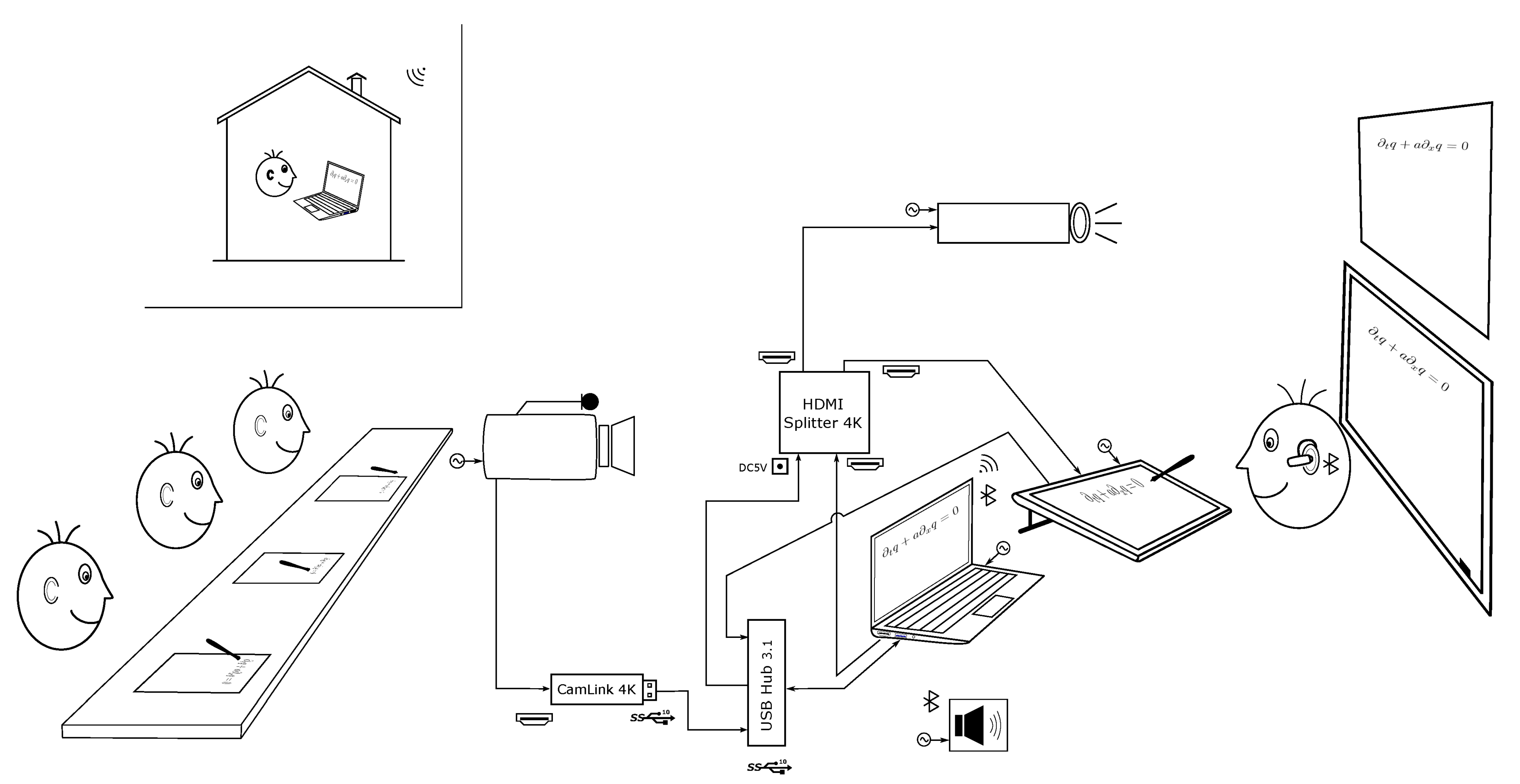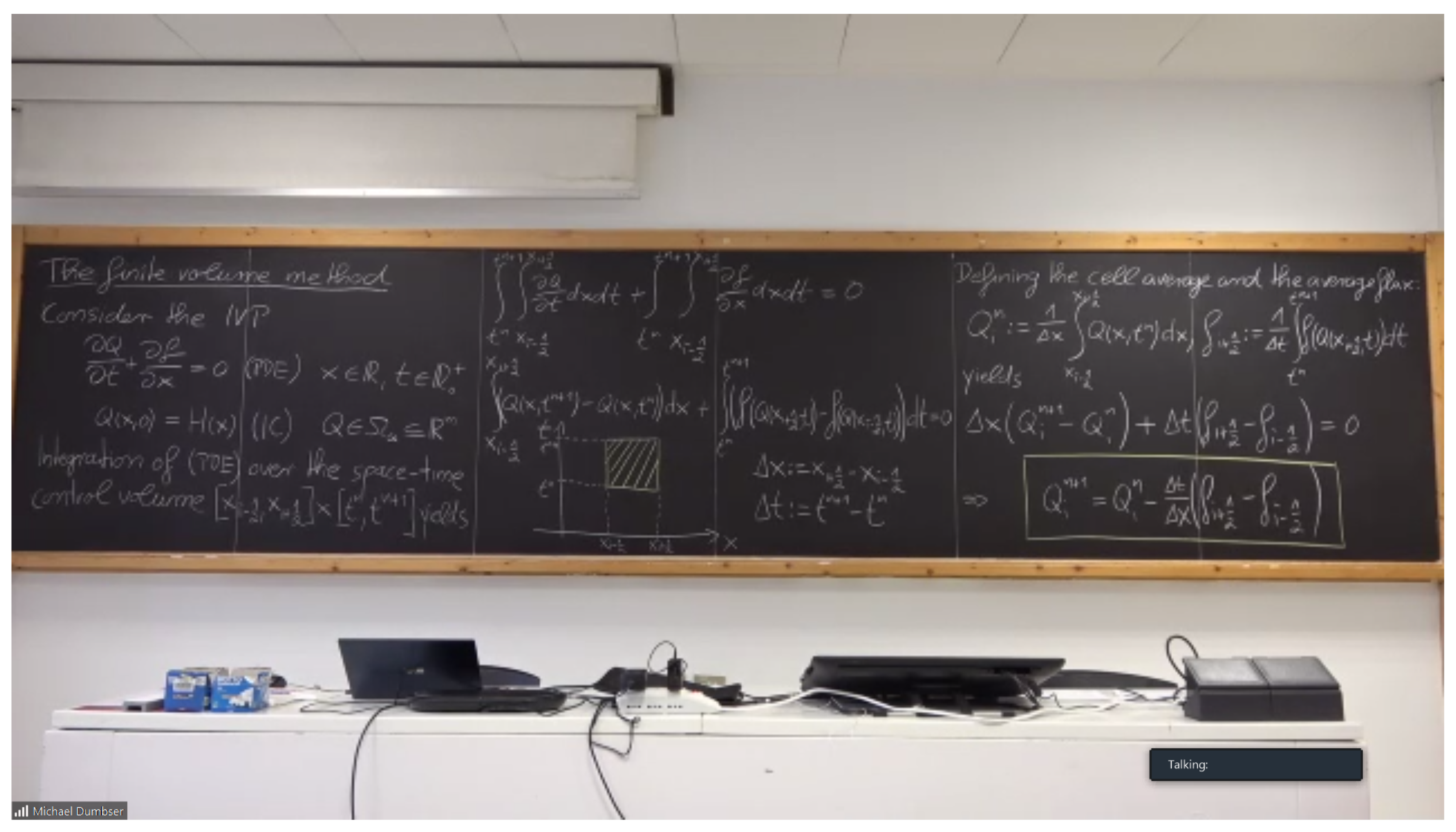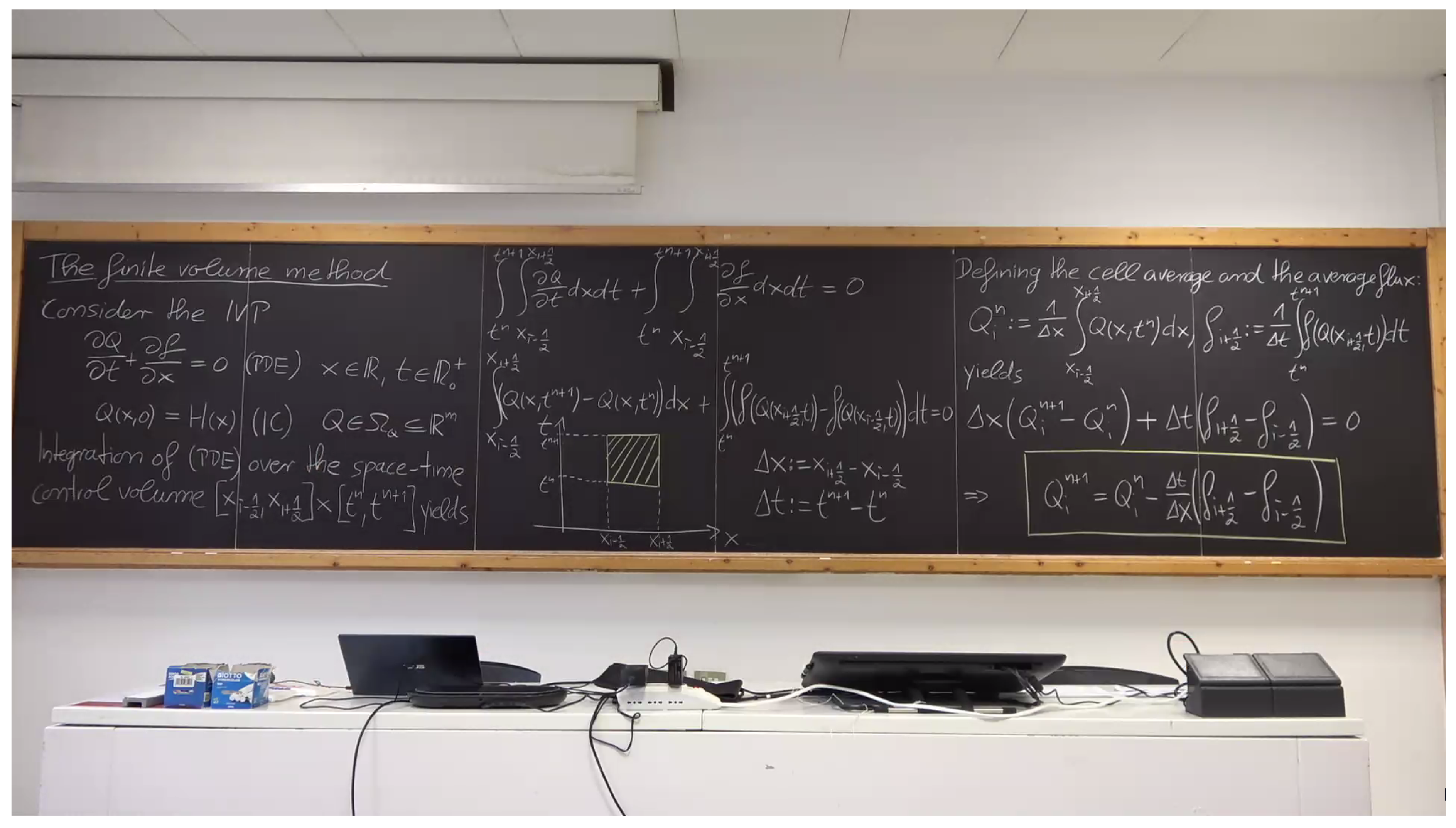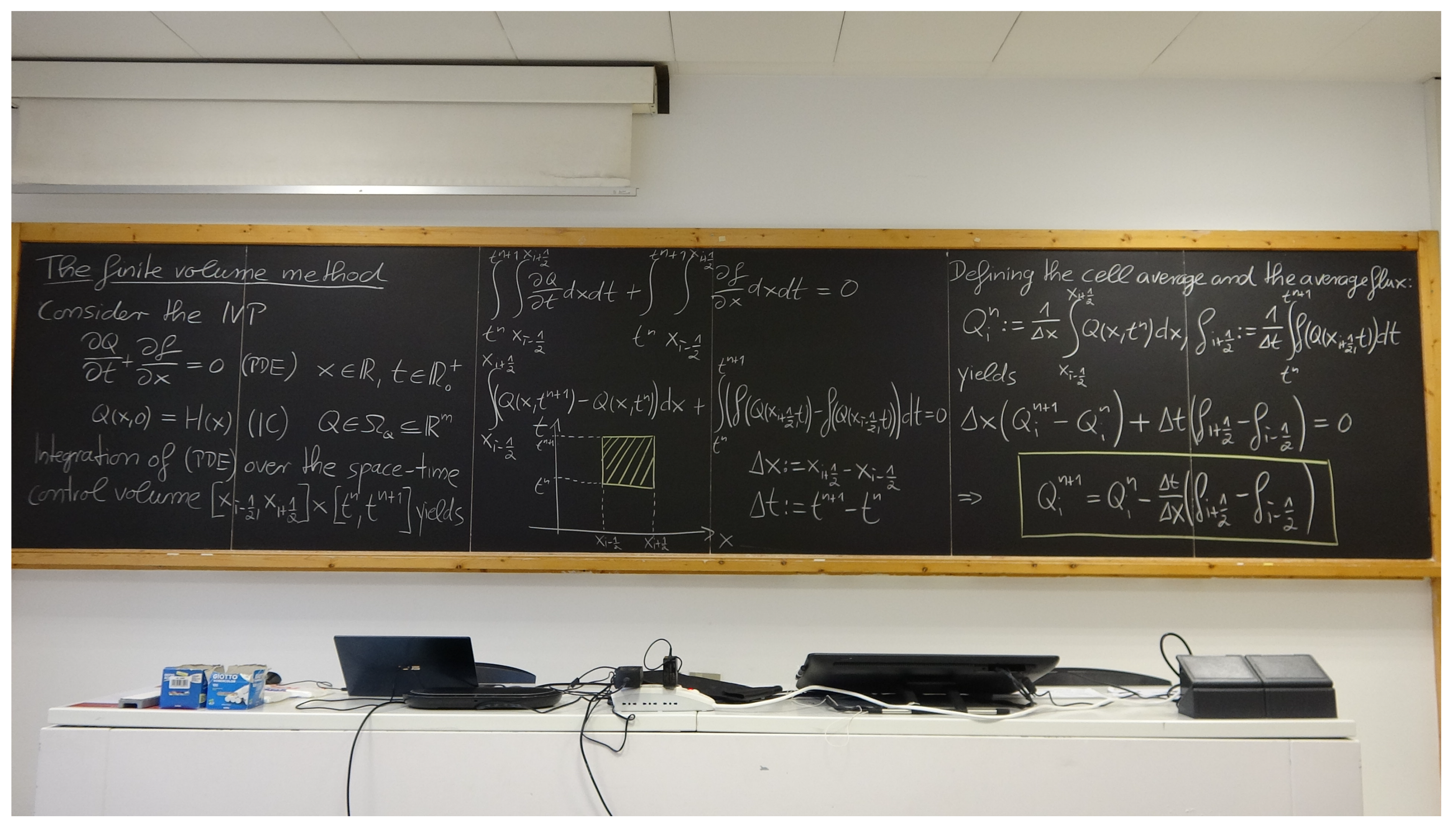A Simple but Efficient Concept of Blended Teaching of Mathematics for Engineering Students during the COVID-19 Pandemic
Abstract
1. Introduction and Context of This Work
2. Blended Teaching Concept at DICAM during the COVID-19 Pandemic
2.1. Typical Structure of the Courses in Mathematics Offered at DICAM
2.2. Experience of the Emergency Phase during the Second Semester 2019/2020
2.3. Main Pillars and General Objectives of the Blended Teaching Concept
2.4. COVID-Specific Part of the Concept
3. Technological and Logistic Realization of the Concept
- The lecture halls at DICAM were not at all prepared for blended teaching and thus needed to be specifically equipped;
- Achieving sufficiently high video resolution online that allows to read complex mathematical formulas clearly, despite the existing COVID-19 bandwidth and HD video feature restrictions;
- Achieving at the same time a sufficiently high audio quality both in the lecture hall and online, in particular capturing the speech with high quality while the professor is turned towards the blackboard while writing and allowing also a clear bidirectional communication;
- The fact that rather complex and relatively new technology needed to be handled by each professor during his/her blended lectures;
- The highly heterogeneous computer hardware and operating systems resulting from the choice of allowing each professor to use his/her personal laptop, which also made the training and technical support particularly challenging and led to a wide set of necessary adapters to connect to the standard hardware installed in each lecture hall.
3.1. Description of the Employed Equipment
- Personal laptop. As already mentioned, the particular setup designed in this case study gives the professor the opportunity to employ his/her own laptop, aiming at minimizing the novelties resulting from the use of new technical devices. Consequently, the laptop of the professor became the main control device of the blended teaching lectures.
- Camcorder. To properly capture the blackboard and transmit physical experiments, a full high-definition camcorder was needed. It was further equipped with a directional microphone to record the speech of the professor in small classrooms. For large blackboards, instead of the standard camcorder proposed here, it was necessary to employ a wide-angle lens camera (e.g., PTZ Minrray UV540) controlled by IR remote control to allow switching between different parts of the blackboard and different levels of zoom.
- Camlink 4K. The transmission of a high-quality video signal from the camcorder to the computer required a 4K HDMI to USB converter. Let us note that although the quality broadcast by these devices goes up to 1080 p at 60 fps or 4K at 30 fps, to reduce bandwidth consumption we suggest to limit the video capturing program to 1080 p at 25 fps.
- Active USB 3.0 extension cable. Typically the camcorder and, consequently, the camlink are far away from the laptop, and thus a USB 3.0 extension cable is needed. To properly preserve the video signal and provide the needed power supply for the camlink, an active cable was employed.
- USB Hub 3.0. To minimize the number of connectors to be plugged into the laptop, they were all gathered in a unique USB hub of four ports that transmits input and output signals to and from the computer. At a minimum, SuperSpeed USB (USB 3.0) cables, connectors and ports are needed to transfer all of the signals, the use of USB 3.1 or 3.2 ports being preferred over USB 3.0 ports.
- Graphics tablet and digital pen system. The alternative system to the blackboard was a rubber grip HD 22 inch graphics tablet that was not hand sensible (i.e., a pen display), so that the writing is as close as possible to traditional handwriting on a piece of paper, used together with the preferred interactive whiteboard software. To be able to import and export PDF documents and save the lecture notes we suggested the use of the OpenBoard (https://openboard.ch/index.en.html) software. Communication of the graphics tablet with the computer was achieved via an input HDMI signal that duplicated the laptop screen and an output USB signal for the recording of the handwriting.
- HDMI splitter. The laptop screen must be shared both with the students in the lecture hall using the projector system and with the graphics tablet. To duplicate the signal an HDMI 4K splitter is employed. Since most projectors at DICAM are only equipped with a VGA input port, an HDMI to VGA converter is connected to the HDMI cable exiting form the HDMI splitter.
- Airlink. To facilitate bidirectional communication, the comments of online students were broadcast through the pre-existing sound system of the large lecture halls using an airlink connected to the laptop via bluetooth. For small and medium classrooms (up to 100 students) and without a pre-installed sound system an alternative was the use of a speakerphone (Jabra Speak 810) that can be connected to the laptop using the audio jack or via bluetooth. The latter device allows listening to the online comments in the lecture hall and also captures the voice of the people present in the classroom to be transmitted online, hence guaranteeing peer interaction, a key point of laboratories and seminars. Meanwhile, the former device only allows the online students to be heard in the lecture hall.
- Ear microphone. In large lecture halls and when the professor is turned towards the blackboard, the use of a directional microphone was not enough to properly capture the speech with high quality. To solve this problem a personal bluetooth ear microphone was employed by each professor.
- Adapters. The resulting hardware of each lecture room, as explained below, requires the personal laptop of each professor to be connected thorough one HDMI and one USB/A port. Due to the great heterogeneity of modern computer hardware, a large set of adapters was made available, allowing to also use VGA, DisplayPort, mini DisplayPort, mini HDMI, micro HDMI and USB-C ports.
3.2. Physical Setup of the Equipment
3.3. High-Quality Audio and Video Online Streaming
3.4. Lecture Setup
- I.
- Blackboard. In this case the auxiliary video capturing software is opened (VLC, OBS, Quicktime), the camcorder is selected as the input source and the regular video stream of ZOOM must be turned off.
- II.
- Graphics tablet. OpenBoard or the preferred interactive whiteboard software is employed. The students in the lecture hall will be able to see the screen of the tablet on the projector screen.
- III.
- Third party software. While sharing the screen any third party software, like classical mathematical programs such as Matlab, Maple, R Studio, Mathematica, or PDF and Powerpoint files can be shown.
3.5. Training and Technical Support
4. Evaluation of the Concept and of Its Practical Implementation
4.1. Quantitative Verification of the Video Quality of the Low-Bandwidth High-Quality Screen Sharing Approach Proposed in This Paper Compared to Standard Video Streaming
4.2. Quantitative Internet Bandwidth Measurements
4.3. Quantitative Evaluation of the Blended Teaching Concept via Ex Post Online Questionnaires
4.4. Moving Beyond: Innovative Didactic Concepts for the Numerical Analysis Course
5. Conclusions
Author Contributions
Funding
Institutional Review Board Statement
Informed Consent Statement
Data Availability Statement
Acknowledgments
Conflicts of Interest
References
- Education: From Disruption to Recovery. 2020. Available online: https://en.unesco.org/covid19/educationresponse (accessed on 1 February 2021).
- Chang, G.C.; Yano, S. How Are Countries Addressing the COVID-19 Challenges in Education? A Snapshot of Policy Measures. GEM Report Unesco 2020. Available online: https://gemreportunesco.wordpress.com/2020/03/24/how-are-countries-addressing-the-covid-19-challenges-in-education-a-snapshot-of-policy-measures/ (accessed on 1 February 2021).
- Conte, G.; Speranza, R. Decreto del presidente del consiglio dei ministri 7 agosto 2020. Ulteriori disposizioni attuative del decreto-legge 25 marzo 2020, n. 19, recante misure urgenti per fronteggiare l’emergenza epidemiologica da COVID-19, e del decreto-legge 16 maggio 2020, n. 33, recante ulteriori misure urgenti per fronteggiare l’emergenza epidemiologica da COVID-19. Gazz. Uff. Della Repubb. Ital. 2020, 161. [Google Scholar]
- Fox, J.; Artemeva, N. The cinematic art of teaching university mathematics: Chalk talk as embodied practice. Multimodal Commun. 2012, 1, 83–103. [Google Scholar] [CrossRef]
- Alibali, M.; Nathan, M.; Wolfgram, M.; Church, R.; Jacobs, S.; Johnson Martinez, C.; Knuth, E. How teachers link ideas in mathematics instruction using speech and gesture: A corpus analysis. Cogn. Instr. 2014, 32, 65–100. [Google Scholar] [CrossRef]
- Maclaren, P.; Wilson, D.I.; Klymchuk, S. Making the point: The place of gesture and annotation in teaching STEM subjects using pen-enabled Tablet PCs. Teach. Math. Appl. Int. J. IMA 2017, 37, 17–36. [Google Scholar] [CrossRef]
- Walkington, C.; Chelule, G.; Woods, D.; Nathan, M. Collaborative gesture as a case of extended mathematical cognition. J. Math. Behav. 2019, 55, 100683. [Google Scholar] [CrossRef]
- Artemeva, N.; Fox, J. The Writing’s on the Board: The Global and the Local in Teaching Undergraduate Mathematics Through Chalk Talk. Writ. Commun. 2011, 28, 345–379. [Google Scholar] [CrossRef]
- Nerantzi, C. The use of peer instruction and flipped learning to support flexible blended learning during and after the COVID-19 Pandemic. Int. J. Manag. Appl. Res. 2020, 7, 184–195. [Google Scholar] [CrossRef]
- Wenger, E. Communities of Practice: Learning, Meaning, and Identity; Cambridge University Press: New York, NY, USA, 1999. [Google Scholar]
- Händel, M.; Stephan, M.; Gläser-Zikuda, M.; Kopp, B.; Bedenlier, S.; Ziegler, A. Digital readiness and its effects on higher education students’ socio-emotional perceptions in the context of the COVID-19 pandemic. J. Res. Technol. Educ. 2020. [Google Scholar] [CrossRef]
- Koi-Akrofi, G.Y.; Owusu-Oware, E.; Tanye, H. Challenges of distance, blended, and online learning: A literature-based approach. Int. J. Integr. Technol. Educ. 2020, 9, 27–39. [Google Scholar] [CrossRef]
- Cronhjort, M.; Filipsson, L.; Weurlander, M. Improved engagement and learning in flipped-classroom calculus. Teach. Math. Appl. Int. J. IMA 2017, 37, 113–121. [Google Scholar] [CrossRef]
- Cong, J.; Wang, M.; Huang, Z. Design and practice of teaching model of measurement and evaluation of mathematics education based on the flipped classroom concept. Adv. Intell. Syst. Comput. 2020, 1117, 1394–1400. [Google Scholar]
- Pisoni, G. Strategies for Pan-European Implementation of Blended Learning for Innovation and Entrepreneurship (I&E) Education. Educ. Sci. 2019, 9, 124. [Google Scholar] [CrossRef]
- Ozadowicz, A. Modified blended learning in engineering higher education during the COVID-19 lockdown—Building automation courses case study. Educ. Sci. 2020, 10, 292. [Google Scholar] [CrossRef]
- Kwan, R.; White, B.; Tse, S.; Eustace, K.; Toon, A.; Samir, A.; Huang Mui Kheng, J.; Kin Chew, L.; Vythilingam, M.; Low Wee Kiat, S. Blended teaching and learning in the School of Science and Technology of UniSIM. Interact. Technol. Smart Educ. 2009, 6, 234–243. [Google Scholar]
- Vázquez-Cendón, M. Informe de Renovación de la Acreditación del Máster Universitario en Matemática Industrial; Universidade de Santiago de Compostela: Santiago, Spain; Universidade de A Coruña: A Coruña, Spain; Universidade de Vigo: Vigo, Spain; Universidad Carlos III de Madrid: Madrid, Spain; Universidad Politécnica de Madrid: Madrid, Spain, 2016. [Google Scholar]
- González-Yebra, Ó.; Aguilar, M.A.; Aguilar, F.J.; Lucas, M. Co-Design of a 3D Virtual Campus for Synchronous Distance Teaching Based on Student Satisfaction: Experience at the University of Almería (Spain). Educ. Sci. 2019, 9, 21. [Google Scholar] [CrossRef]
- McKnight, K.; O’Malley, K.; Ruzic, R.; Horsley, M.K.; Franey, J.J.; Bassett, K. Teaching in a Digital Age: How Educators Use Technology to Improve Student Learning. J. Res. Technol. Educ. 2016, 48, 194–211. [Google Scholar] [CrossRef]
- Naidoo, J.; Singh-Pillay, A. Exploring Mathematics Teachers’ Professional Development: Embracing the Fourth Industrial Revolution. Univers. J. Educ. Res. 2020, 8, 2501–2508. [Google Scholar] [CrossRef]
- Fan, X.; Li, W.; Wang, Z.; Sun, Y.; Su, L. The analysis of higher mathematics teaching strategy based on the innovative teaching mode. Adv. Intell. Syst. Comput. 2021, 1195, 344–353. [Google Scholar]
- Ma, X.; Fan, X.; Li, W.; Li, J.; Li, Q. The exploration and research of blended teaching mode based on “internet+” big data cloud platform. Adv. Intell. Syst. Comput. 2021, 1195, 334–343. [Google Scholar]
- Fernández-Caramés, T.; Fraga-Lamas, P. Use case based blended teaching of IIoT cybersecurity in the industry 4.0 era. Appl. Sci. 2020, 10, 5607. [Google Scholar] [CrossRef]
- Garres Díaz, J.; Herrera, J.; Albujer, A.; Caballero, M.; Morales de Luna, T. Análisis de la Adaptación de la Docencia virtual Universitaria Durante la COVID-19; Technical Report; University of Cordoba: Cordoba, Spain, 2020; Available online: https://www.researchgate.net/profile/Tomas_Morales_de_Luna (accessed on 1 February 2021).
- Carrillo, C.; Flores, M.A. COVID-19 and teacher education: A literature review of online teaching and learning practices. Eur. J. Teach. Educ. 2020, 43, 466–487. [Google Scholar] [CrossRef]
- Gamage, K.; Wijesuriya, D.; Ekanayake, S.Y.; Rennie, A.E.W.; Lambert, C.G.; Gunawardhana, N. Online delivery of teaching and laboratory practices: Continuity of University programmes during COVID-19 pandemic. Educ. Sci. 2020, 10, 291. [Google Scholar] [CrossRef]
- Smith, J.; Guimond, F.A.; Bergeron, J.; St-Amand, J.; Fitzpatrick, C.; Gagnon, M. Changes in Students’ Achievement Motivation in the Context of the COVID-19 Pandemic: A Function of Extraversion/Introversion? Educ. Sci. 2021, 11, 30. [Google Scholar] [CrossRef]
- Racine, N.; Cooke, J.L.; Eirich, R.; Korczak, D.J.; McArthur, B.; Madigan, S. Child and adolescent mental illness during COVID-19: A rapid review. Psychiatry Res. 2020, 292, 113307. [Google Scholar] [CrossRef] [PubMed]
- Petronzi, R.; Petronzi, D. The Online and Campus (OaC) model as a sustainable blended approach to teaching and learning in higher education: A response to COVID-19. J. Pedagog. Res. 2020, 4, 498–507. [Google Scholar] [CrossRef]
- Skulmowski, A.; Rey, G.D. COVID-19 as an accelerator for digitalization at a German university: Establishing hybrid campuses in times of crisis. Hum. Behav. Emerg. Technol. 2020, 2, 212–216. [Google Scholar] [CrossRef]
- Maciejewski, W. Flipping the calculus classroom: An evaluative study. Teach. Math. Appl. Int. J. IMA 2015, 35, 187–201. [Google Scholar] [CrossRef]
- Wilson, D.; Maclaren, P. From Chalk Talk to Tablet Talk: Pedagogies for Control Engineering. IFAC Proc. Vol. 2013, 46, 144–149. [Google Scholar] [CrossRef]
- Maclaren, P. The new chalkboard: The role of digital pen technologies in tertiary mathematics teaching. Teach. Math. Appl. 2014, 33, 16–26. [Google Scholar] [CrossRef]
- Bigoni, D. Nonlinear Solid Mechanics: Bifurcation Theory and Material Instability; Cambridge University Press: New York, NY, USA, 2012. [Google Scholar]
- Quarteroni, A.; Valli, A. Numerical Approximation of Partial Differential Equations; Springer Series in Computational Mathematics; Springer: Berlin/Heidelberg, Germany, 1994; Volume 23. [Google Scholar]
- Toro, E.F. Riemann Solvers and Numerical Methods for Fluid Dynamics: A Practical Introduction; Springer: Berlin/Heidelberg, Germany, 2009. [Google Scholar]
- Sanz-Pérez, E.S. Students’ performance and perceptions on continuous assessment. Redefining a chemical engineering subject in the European higher education area. Educ. Chem. Eng. 2019, 28, 13–24. [Google Scholar] [CrossRef]








| Questionnaire Number | Main Purpose of the Questionnaire | Type | Number n of Answers Received |
|---|---|---|---|
| AS1 | Obtaining students’ preferences and expectations concerning blended teaching to design the case study | ex ante | 445 students |
| AP1 | Binding choice of the professors whether to teach on-site (blended), or purely online | ex ante | 68 professors |
| AS2 | Binding choice of the students to attend on-site or online needed for the strict access rules to the university buildings | ex ante | 1011 students |
| PS1 | Evaluation of the students’ appreciation of the proposed blended teaching concept implemented in this case study | ex post | 509 students |
| PP1 | Evaluation of the professors’ opinion concerning the proposed concept for the area of mathematics and theoretical mechanics | ex post | 6 professors |
| Questions | Answers with Absolute Numbers |
|---|---|
| 1. Which online teaching modality do you prefer? | asynchronous (47) |
| synchronous without recording (17) | |
| synchronous with recording (257) | |
| depends on the lecture (67) | |
| depends on the professor (42) | |
| no opinion (15) | |
| 2. Does seeing the body language and the facial expressions of the professor make the lecture more interesting? | 0—no opinion (20) |
| 1—not at all (1) | |
| 2—a bit (17) | |
| 3—a lot (87) | |
| 3. Is the use of the blackboard as a traditional means of teaching useful? | 0—no opinion (29) |
| 1—not at all (1) | |
| 2—a bit (11) | |
| 3— a lot (81) | |
| 4. Do you consider the option to attend the lectures of the first semester of 2020/2021 only online? | 0—no (263) |
| 1—yes (162) |
| Question | Answers with Absolute Numbers |
|---|---|
| In the next semester, do you want to attend blended lectures on-site? | yes (830) |
| Note: if you choose no, you will not be authorized to enter the university buildings during this semester. | no (181) |
| Questions | Answers with Absolute Numbers |
|---|---|
| 1. How do you plan to teach your course next semester? | on-site blended (47) |
| Note: if you choose exclusively online, no lecture hall will be assigned to your course for the entire semester | exclusively online (21) |
| 2. Do you agree with the proposed staggered timetable between blended on-site and purely online lectures? | yes (62) |
| no (6) |
| Equipment | Cost Estimate in EUR |
|---|---|
| Laptop of the professor | 0 |
| Panasonic HC-V770 camcorder | 408 |
| Elgato Camlink 4K HDMI to USB converter | 130 |
| Ugreen 10 m active USB 3.0 extension cable | 43 |
| Anker USB hub 3.0 | 13 |
| Wacom Cintiq 22 graphics tablet | 953 |
| 4K HDMI splitter Ablewe | 16 |
| Primewire 2m HDMI cable | 10 |
| Ugreen HDMI to VGA adapter | 10 |
| BT DW 20BR Klark Teknik bluetooth airlink | 89 |
| Jabra talk 25 bluetooth ear microphone * | 28 |
| Total amount: | 1700 |
| Questions | Answers with Absolute Numbers |
|---|---|
| 1. How do you typically attend the lectures? | in presence (266) |
| online (160) | |
| both (online and in presence) (83) | |
| 2. How do you evaluate the quality of the blended teaching compared to pure online teaching? | better (387) |
| equal (100) | |
| worse (22) | |
| 3. Are you overall satisfied with the blended teaching concept offered at DICAM? | yes (487) |
| no (22) | |
| 4. How do you evaluate the video quality of the blended teaching concept at DICAM? | 4—very good (256) |
| 3—good (179) | |
| 2—fair (66) | |
| 1—not acceptable (8) | |
| 5. How do you evaluate the audio quality of the blended teaching concept at DICAM? | 4—very good (269) |
| 3—good (181) | |
| 2—fair (54) | |
| 1—not acceptable (5) | |
| 6. What are the main advantages of blended teaching compared to pure online teaching? (multiple answers allowed) | more and easier interaction with professors (310) |
| more and easier interaction with colleagues (289) | |
| use of blackboard improves learning efficiency (267) | |
| seeing the professor makes lectures more engaging (243) | |
| there are no advantages (32) | |
| 7. What are the main advantages of blended teaching compared to traditional teaching? (multiple answers allowed) | possibility to attend lectures also being sick/in quarantine (411) |
| flexibility to attend in presence or online acc. to personal needs (353) | |
| availability of recorded lectures (326) | |
| introduction of innovations in teaching in itself (17) | |
| there are no advantages (10) |
| Questions | Answers with Absolute Numbers |
|---|---|
| 1. Which instruments do you use for teaching? | blackboard (5) |
| graphics tablet (1) | |
| slides (0) | |
| 2. How do you evaluate the quality of the technical equipment made available by DICAM for blended teaching? | 4—excellent (4) |
| 3—very good (2) | |
| 2—good (0) | |
| 1—fair (0) | |
| 0—insufficient (0) | |
| 3. How do you evaluate the quality of the training courses offered by DICAM for blended teaching? | 4—excellent (4) |
| 3—very good (2) | |
| 2—good (0) | |
| 1—fair (0) | |
| 0—insufficient (0) | |
| 4. How important is technical support for blended teaching? | 3—very important (3) |
| 2—important (2) | |
| 1—indifferent (1) | |
| 0—not needed (0) | |
| 5. How do you evaluate the quality of the technical support provided by DICAM for blended teaching? | 4—excellent (5) |
| 3—very good (1) | |
| 2—good (0) | |
| 1—fair (0) | |
| 0—insufficient (0) | |
| 6. How do you evaluate the quality of bidirectional communication with the students online? | 4—excellent (1) |
| 3—very good (3) | |
| 2—good (0) | |
| 1—fair (2) | |
| 0—insufficient (0) | |
| 7. Compared to pure online teaching, how do you evaluate the overall quality of on-site blended teaching? | 3—much better (4) |
| 2—better (2) | |
| 1—the same (0) | |
| 0—worse (0) | |
| 8. What are the main advantages of blended teaching compared to pure online teaching? (multiple answers allowed) | the possibility to use traditional teaching instruments (4) |
| the possibility to see the students’ reactions (3) | |
| improves the direct interaction with the students (2) | |
| improves the overall quality of teaching (4) |
Publisher’s Note: MDPI stays neutral with regard to jurisdictional claims in published maps and institutional affiliations. |
© 2021 by the authors. Licensee MDPI, Basel, Switzerland. This article is an open access article distributed under the terms and conditions of the Creative Commons Attribution (CC BY) license (http://creativecommons.org/licenses/by/4.0/).
Share and Cite
Busto, S.; Dumbser, M.; Gaburro, E. A Simple but Efficient Concept of Blended Teaching of Mathematics for Engineering Students during the COVID-19 Pandemic. Educ. Sci. 2021, 11, 56. https://doi.org/10.3390/educsci11020056
Busto S, Dumbser M, Gaburro E. A Simple but Efficient Concept of Blended Teaching of Mathematics for Engineering Students during the COVID-19 Pandemic. Education Sciences. 2021; 11(2):56. https://doi.org/10.3390/educsci11020056
Chicago/Turabian StyleBusto, Saray, Michael Dumbser, and Elena Gaburro. 2021. "A Simple but Efficient Concept of Blended Teaching of Mathematics for Engineering Students during the COVID-19 Pandemic" Education Sciences 11, no. 2: 56. https://doi.org/10.3390/educsci11020056
APA StyleBusto, S., Dumbser, M., & Gaburro, E. (2021). A Simple but Efficient Concept of Blended Teaching of Mathematics for Engineering Students during the COVID-19 Pandemic. Education Sciences, 11(2), 56. https://doi.org/10.3390/educsci11020056





